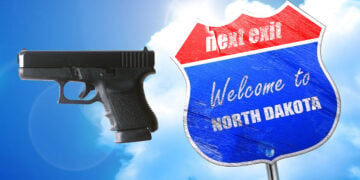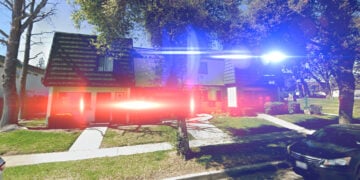If you are a parent, you are probably well aware of the constant worry we have for our children, not the least of which involves the possibility of violence. Little children must be in the constant care of adults, obviously, to protect them from a myriad of dangers, including violence. However, once a child is of considerable size, perhaps in the early teenage years or even the tween years, they likely need to start spreading their wings. A protective parent needs to walk the fine balance between safety and allowing a child some new-found independence.
Every circumstance is different but in terms of judging when a child is old enough to perhaps walk alone to the bus stop in the morning, or walk to a friend’s house in the neighborhood alone, that the child needs to be mature enough to be trustworthy, and should be physically large enough to no longer be easily carried off by an adult. A large twelve-year-old boy, for example, is likely old enough to venture to close-by places unattended, as they are big enough to not be easy targets of kidnapping (a twelve-year-old boy can likely put up as much fight as most adult women). However, the maturity level will vary from child to child. Girls of this age may or may not be as physically formidable, again, being a judgment call for the parents.
Teaching Awareness and Skills
When educating children about violence, we should not try to scare them, but we should instill in them a realistic outlook on the world. First, let’s get over the reminiscence of our own childhoods, in which baby boomers, Gen X’ers, and even early Millennials seem to think that the world was a safe and wonderful place when we were growing up, and it is just terrible now. That is not the case. In fact, any basic research shows that child abduction was more common in the much-glorified Eighties than it is now. This author proposes that the decline in such predation is due simply to the fact that most parents now are “helicopter parents,” and there is simply less opportunity for sickos to abduct kids than during our youth. There is, likely, just as many sickos still around, if not more, so the danger is still real.
Regardless of current crime trends, a cautious parent should be protective but not stifling. Be honest with children as to the threats that exist in their world. Start instilling self-defense mindset lessons, and physical lessons, early. While firearms will be a self-defense option to be carried only as an adult, an early introduction to the safe and competent handling of firearms is a good thing. Self-defense training should not instill fear in children but should empower them and give them a developed confidence in their own heightened awareness and skillset.
Tools for Defense
When it comes to a defensive toolset for children, it is complicated. Obviously, in most situations and environments, guns and blades are out of the question. If a tween or early teenager proves mature enough, less-lethal tools may be an option. One must verify what their own state and district laws are. For example, in many places, it is illegal to carry OC spray if younger than sixteen, or fourteen, etc…, so be cognizant of this. Beyond the legal considerations must be the serious consideration of the maturity level of the child. Even if legal, can a given twelve-year-old be trusted with OC Spray? Imagine the ramifications of the child getting in a tussle with some neighborhood rivals that ends in the neighbor’s kid getting doused in OC spray. Not a good way to make neighbors and expect a visit from law enforcement. Tread carefully here.
If a child is old enough to walk to the neighbor’s house or take the dog for a walk, etc…, there is a strong inclination among wary parents to arm them with at least something. The cautious consideration here is the judgment of the child. Will they act responsibly with the tool or not? There is a tremendous liability in arming a kid with any force multiplier, so tread carefully.
One of the more feasible options here may be impact tools. It is not uncommon for children to walk to a friend’s house with a baseball bat in hand to go play ball, and nothing about this tool stands out. A big twelve-year-old with a baseball bat becomes a rather hard target. This is a formidable tool for not only dissuasion against creeps but against aggressive dogs as well, a likely more common threat in any given suburban neighborhood. For something smaller, a good flashlight with some training in using it as an impact tool provides a multi-use device that can do a lot.
Tracking
While this author blames modern technology for many problems among all of society, and in particular, youth, there are some advantages to this technology as well. An adolescent that is trustworthy enough to make short trips to close-by destinations should, perhaps, have a phone with them so that they can communicate with parents or guardians when necessary. Another benefit that comes with a phone beyond communication is a tracking option, as there are programs that can allow the phone’s location to be determined. Consider also other options, such as Apple Air Tags that can be placed in a child’s bag or the like so that they can be tracked and located easily. While this may seem invasive to privacy, we are discussing the care of dependent children, not autonomous adults.
The Buddy System
Another asset to leverage with children is perhaps the most formidable; numbers. Two tweens together become exponentially more resistant to predation compared to a single child. Teaming up with neighbors, for example, to walk to the bus or similar, in pairs is wise. A group of tweens or young teenagers becomes far more capable of dealing with the encroachment of a dangerous entity than does any single child by themselves. Being free from adult supervision, although in groups, still fosters the sense of independence that is beneficial, yet is far safer in numbers.
Being a parent is a difficult occupation, but the truth is that it has always been. We live in a world with some unique problems, but many of these dangers have been around for decades as well. We should equip our children to face the world they are handed, and part of that required skillset is the ability to recognize and defend against danger.











Personally, I carried a razor sharp Buck 110 in my right front pocket all through high school.